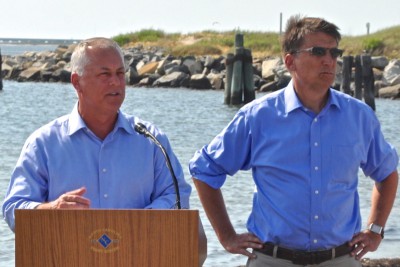From an Outer Banks Voice report.
NAGS HEAD — Gov. Pat McCrory declared Monday a “historic day for the people who call the Outer Banks home and the millions of visitors who travel here each year. Today, we begin building a bridge that has been more than two decades in the making.”
Supporter Spotlight
With that, the governor confirmed what many Outer Banks residents and visitors learned a few hours earlier:
The Southern Environmental Law Center, representing Defenders of Wildlife and the National Wildlife Refuge Association, will withdraw its legal challenges against building a parallel replacement to the Bonner Bridge.

Joined by state officials and law center and refuge association representatives, McCrory held a press conference on a steamy beach at the southern end of the Bonner Bridge.
The backdrop: An Army Corps dredge and returning charter boats gliding through Oregon Inlet.
While much work remains concerning a permanent fix for the new inlet cut by Hurricane Irene in 2011 and the paved portion of N.C. 12 through the Pea Island National Wildlife Refuge, the players in the years-long struggle now seem to be moving in the same direction.
Supporter Spotlight
“This has been more than two decades in the making and I’m convinced if these groups had not had viable discussions during the past many months this could have been delayed for another decade, and that is totally unacceptable,” McCrory said.
Before Monday, many wondered if a new bridge would ever be built. Legal negotiations were dragging into their ninth month in an effort to settle lawsuits filed by the environmental groups that had stopped work under a $216 million contract awarded in 2011.
The bridge is the only land connection to Hatteras Island and is well past its expected lifespan. Opened in 1963, it was built to last 30 years. Now, it is considered structurally deficient but still safe after more than $50 million in continual repairs.
What We Know
The state will replace the Bonner Bridge with a parallel span across Oregon Inlet. Chosen by the state in 2011, PCL Civil Constructors and HDR Engineering were notified June 15 to prepare to resume work. But the contract price will be higher now due to the four-year delay.
The conservation groups will dismiss state and federal lawsuits against the Bonner replacement, and the state will cease work on a permanent bridge in the current easement over the Pea Island breach created in 2011 by Hurricane Irene. A temporary span was put up after the storm, and so far $3.9 million has been spent by the state on a permanent bridge.
The groups had long advocated a 17-mile bridge over the Pamlico Sound to bypass Pea Island, where N.C. 12 continually suffers washouts. The Army Corps of Engineers has added sand to the beach to protect a chronic “hot spot” at Mirlo Beach north of Rodanthe.
At the heart of the primary lawsuit was the contention by conservationists that fixing N.C. 12 should have been included in environmental studies for the Bonner replacement. Instead, the state opted to proceed with the parallel span and deal with N.C. 12 south of it later.
DOT will implement interim measures to ensure safe motor travel over the Pea Island breach as it works with state and federal agencies to settle on a satisfactory permanent solution. They will explore building causeways in Pamlico Sound bypassing the Pea Island inlet and the area north of Mirlo Beach in Rodanthe.

The state’s preferred option for Rodanthe/Mirlo Beach is a “jug-handle bridge,” which previously was considered by DOT in earlier environmental studies.
It will take at least three years to complete the new Bonner Bridge, and it is hoped work can begin in March 2016 once the lawsuits are officially dismissed.
In essence, with the Mirlo/Rodanthe jug-handle bridge option and the approval of all parties to dismiss lawsuits against the Bonner Bridge replacement, two of the three major legal issues appear to be resolved.
It is thought that once the new Bonner Bridge is finished, some of the shoaling issues in Oregon Inlet will be mitigated by new channels and spans located in deeper water farther to the south.
The Southern Environmental Law Center, at present, is opposed to any plans that would allow N.C. 12 to continue to exist within the present easement that was agreed to by the state and federal authorities decades ago.
What We Don’t Know
Questions not answered Monday include the new cost of the Bonner Bridge, given the four-year delay, and of the “jug-handle” bridge in Mirlo Beach. The route of that bridge also wasn’t discussed or how much of Rodanthe will be bypassed.
How the N.C. General Assembly and DOT will fund all of the above as the agreement moves forward is also still a big question.








